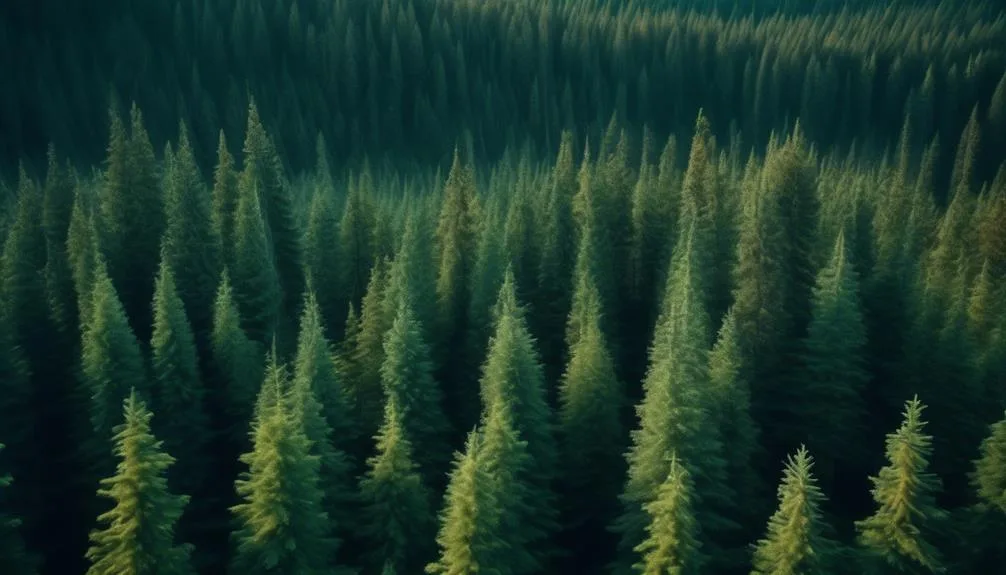Ever wondered how tall spruce trees can grow? These towering conifers have more to their height than meets the eye. Understanding their growth involves exploring different spruce types and the factors that influence their height.
How do environmental conditions and genetics determine their ultimate height? It's a fascinating journey into the natural world.
Factors Affecting Spruce Tree Height
Understanding the environmental and genetic factors influencing spruce tree height is essential for effective cultivation and management.
Soil composition plays a crucial role in the growth of spruce trees. The acidity, drainage, and nutrient levels of the soil all impact the tree's ability to develop strong roots and sustain vertical growth. For instance, spruce trees thrive in well-drained, acidic soils with a good balance of nutrients.
Additionally, precipitation patterns significantly affect spruce tree height. Adequate and consistent rainfall promotes healthy growth, while prolonged drought conditions can stunt the tree's development.
Understanding and carefully managing these factors can help ensure that spruce trees reach their full height potential in the most optimal conditions.
Types of Spruce Trees and Their Heights
The influence of soil composition and precipitation patterns on spruce tree height underscores the importance of understanding the various types of spruce trees and their respective heights. Different tree species exhibit varying growth rates and can reach different maximum heights.
Here are a few examples:
- Norway Spruce (Picea abies): This species can grow up to 115 feet tall and is known for its rapid growth, especially in its early years.
- White Spruce (Picea glauca): These trees typically reach heights of 40-60 feet and have a moderate growth rate, adapting well to various soil conditions.
- Colorado Blue Spruce (Picea pungens): This species can grow up to 75 feet tall and is valued for its striking blue-green needles.
Understanding the growth rates and maximum heights of these different tree species can help in selecting the right type of spruce for specific landscaping or forestry needs.
Environmental Conditions and Growth
In different environmental conditions, spruce trees exhibit varying growth patterns and adaptability to specific climates, impacting their ultimate height and overall health.
Soil fertility plays a crucial role in determining the height of spruce trees. In nutrient-rich soils, these trees tend to grow taller and healthier.
Climate also significantly influences their growth, with spruce trees thriving in cool, moist environments.
As they age, spruce trees face competition from surrounding vegetation, which can limit their upward growth. Younger trees are more adaptable and can adjust their growth patterns to compete with other plants for sunlight and nutrients.
Understanding the impact of environmental factors on spruce tree growth is essential for effective forestry management and conservation efforts.
Average Height of Mature Spruce Trees
Mature spruce trees typically reach heights ranging from 40 to 100 feet, depending on environmental factors and genetic characteristics. The average height of these majestic trees is influenced by various factors, including growth patterns and tree health.
- Genetic Characteristics: Different species of spruce trees have varying growth patterns and maximum attainable heights. Some species are naturally inclined to reach greater heights compared to others.
- Environmental Factors: The availability of sunlight, moisture levels, and soil quality significantly impact the growth of spruce trees. Adequate sunlight exposure and rich, well-drained soil can promote healthier and taller spruce trees.
- Tree Health: The overall health of the tree, including resistance to diseases and pests, plays a crucial role in determining its height potential. Well-maintained and disease-resistant spruce trees tend to grow taller and maintain their height better over time.
Tallest Recorded Spruce Tree Heights
Reaching towering heights that inspire awe, recorded spruce trees have soared to astonishing dimensions, standing as testaments to the remarkable potential of these majestic conifers. The growth patterns of spruce trees have led to the development of some of the tallest trees on record. Historical measurements have revealed some truly remarkable heights reached by these trees. Below is a table showcasing some of the tallest recorded spruce tree heights:
| Tree Species | Height (meters) |
|---|---|
| Sitka Spruce | 96.7 |
| Norway Spruce | 63.79 |
| White Spruce | 56.7 |
| Colorado Spruce | 36.88 |
| Black Spruce | 26.4 |
These historical measurements demonstrate the immense potential for spruce trees to reach extraordinary heights, solidifying their status as some of the tallest trees in the world.
Conclusion
In the realm of spruce trees, the potential for height is influenced by various factors, including species, environment, and genetic makeup. While mature spruces typically reach 40-60 feet, exceptional specimens have soared past 200 feet, showcasing nature's awe-inspiring grandeur.
As we marvel at these majestic giants, we're reminded of the profound diversity and resilience of the natural world.

My interest in trees started when I first saw the giant sequoias in Yosemite.
I was a teenager then, and I remember thinking, “I need to learn more about this.”
That moment stuck with me.
A few years later, I went on to study forestry at Michigan Tech.
Since graduating, I’ve worked in a mix of hands-on tree care and community education.
I’ve spent over ten years helping people understand how to plant, maintain, and protect the trees in their neighborhoods.
I don’t see trees as just part of the landscape.
They are living things that make a real difference in our daily lives.
